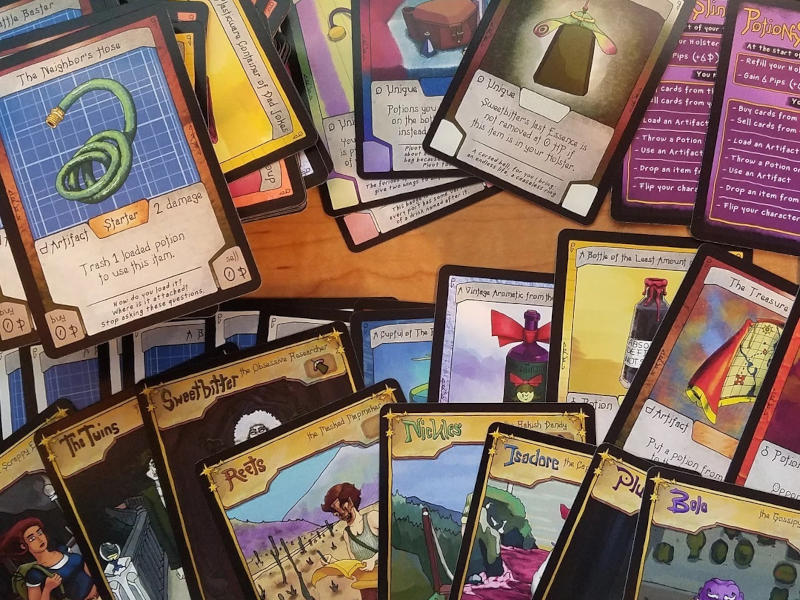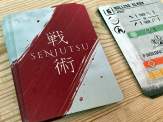| Release Date: 2022 | Players: 2-4 |
| Designer: Anthony Fasano | Length: 45-60 minutes |
| Artist: Anthony Fasano | Age: 10+ |
| Publisher: self-published | Complexity: 2.5 / 5 |
| Plastic (by weight): <10% | Air (by volume): <10% |
Look at the market. There are potions, vessels, artefacts and rings. Some are too expensive and others just don’t let me mix up powerful concoctions. The Finger Ring of the Additional Pinkie looks useful and the Ghost Beaker is also a promising start. So let me buy both, add them to my deck and then see if, on my next turn, they would allow me to join the league of PotionSlingers by Anthony Fasano.
PotionSlingers is advertised as “a card comboing brew ha-ha” and I think that sums it up nicely. The game tries to create something new in the already quite saturated genre of deck-building card-battling games. There are dozens upon dozens of cards depicting potions, vessels, artefacts and rings, which you can acquire on your turn. Potions deal damage to opponents on their own or they can be mixed together in a vessel to hopefully increase their potency or loaded into an artefact like you load foam arrows into your Nerf gun (other brands are available). Rings, meanwhile, tend to give you some sort of protection, increase the power of your attack or add some other permanent ability.
So far, nothing new really. The gameplay in PotionSlingers will also be very familiar to you if you’ve ever played another deck-building card-battling game. Draw cards, buy cards, play cards and deal damage or heal. You can play with up to four players, allowing you to choose who you want to attack and making it probably a bit more fun than some two-player-only card-battling games. However, it’s all very common fare and won’t surprise anyone.
PotionSlingers with a Difference
There are a few things that PotionSlingers does differently and that I haven’t seen in other games.
First of all, your draw deck is face up. Cards you buy go on top, while cards that get used during an attack are added to the bottom. You never shuffle the draw deck either. Instead, you simply draw from the top. That allows you to plan ahead a little. You know which cards you will draw on your next turn, but so will everyone else.
Secondly, everyone tracks their damage with so-called essence cubes. These represent 10 HP, health points and everyone starts with a certain number of them. As you get attacked, you move the cube down a track until it reaches 0. However, once you’re at 0, additional damage doesn’t hurt you. When it is your turn again, you remove the cube from the 0 space and discard it. Then you add a fresh essence cube to the 10 position of your health track. It’s a neat way to stop a group of players from ganging up on someone else. You get a quick breather while you’re knocked out. You’re safe from further attack until the round comes back to you.
What’s also a bit unusual is that you can combine cards. Some cards get more powerful if you tuck certain other cards under them. It’s all about the potions that come in a number of different colours and it’s certain colour combinations that create interesting effects. That’s the combo element of PotionSlingers that I mentioned at the beginning of this review.
Everyone also plays a different character, each with their own unique power. Some are more powerful, but harder to play, while others are weaker, but easier to integrate into your strategy.
High-Quality Components
Something that really stands out for me with PotionSlingers is the component quality.

Get yourself a wooden Tabletop Games Blog dice tray.
Each tray is the perfect size to roll your dice, and with the soft mat, it’s really quiet, while the wooden frame makes it wonderfully sturdy.
There are amber colour translucent plastic cubes, which are used as the essence cubes during play. A custom ten-sided dice is used to track how much money, called pips in the game, you have on your turn. That’s really useful because you not only buy cards, but you can also sell some. So how much you have will go up or down. You can also keep some pips for during your turn to spend on special powers or activate bonuses on some of the cards.
The game comes with a player aid card for everyone that describes the overall turn structure and the actions you can carry out, which is really helpful. Everyone also gets a really thick, dual-layer player board. That board is really only used to store essence cubes and track your HP. That’s its only function. However, it is nice to have and I prefer it to health dials or using HP value cards or similar. It’s really functional and a nice addition.
The box is really full to the brim. You really get a lot of components for your money. There is hardly any air in the box, which I love. There is also a great plastic insert which makes everything fit nicely. That means you can chuck the box around and everything will remain in place. That’s something not many games can achieve.
Lower Quality Visual Appeal
It’s not all rosy though. The illustrations aren’t my cup of tea. I’m sure the style was chosen intentionally and appeals to some people. For me though, it’s not clean enough and looks a bit messy.
The same goes for graphic design. I know it’s nice to have a thematic font. While that works on the box cover and maybe for some of the branding, you need an easy-to-read font for the rulebook and the cards. I can almost forgive the use of the PotionSlingers font in the rulebook, because it’s actually pretty readable, but the problem with the fancy font becomes really apparent on the cards.
Like in other deck-building games, it’s important to be able to read the card text in PotionSlingers. You can read the text when you hold the cards in your hand or have them there on the table in front of you. However, there is a shared card market in the middle of the table. Even on a small table, it will still be hard for people to read the card text on those cards. People need to pick them up to be able to read what their effects are. An easy-to-read font would have made a huge difference here.

Gameplay Refinements
I also think that the gameplay could have benefited from refining. I love how you can combine potions to create combo effects. I love how potions are mixed in vessels or loaded into artefacts. Some of the ring abilities are also good fun. The game also starts to flow better after a few turns, even though it does take a little while to remember which cards get trashed and which are put at the bottom of your draw deck on your turn.
The problem I have with PotionSlingers is that you feel like you should be able to plan ahead and create a strategy, but as soon as you’ve got the vessel or artefact you wanted, the potions you need are probably no longer available. You’re really just reacting to what’s available in the market. You buy cards that you can use on your next turn, then play the cards that are in front of you and hope that they give you useful combos. Sometimes you can really mess with another player, forcing them to trash some of their cards. Other times you can deal a huge amount of damage. Most of the time though, you’re just doing the best with the cards you have. It really doesn’t feel like you’ve got much control.
The reason for this is also why PotionSlingers is different to many other deck-building card-battling games. Rather than literally building up a deck with useful cards and then thinning out the ones you no longer need, in PotionSlingers you constantly drain your deck, because you have to trash cards. You never build up a deck. You’re constantly recycling through cards and heavily rely on the card market to replenish what you need.
Labour of Love
Now don’t get me wrong. I can see how much love has gone into this game. It’s clearly a passion project and I can see that there will be people who love it. However, it also feels a bit like things went a bit too far. The sheer number of cards, each with its own name and illustration, is impressive, but a smaller, more refined deck that was designed to improve the chances of creating powerful combos would have been better, in my view.
I am sure that when you play PotionSlingers a lot, you will know the cards so well that you feel more in control. When you play the game for the first time though, it feels like you are better off just slinging potions at your opponents and not bothering with vessels or artefacts. Sure, you can deal more damage with the latter than you can with potions alone, but it takes time to load them and get them ready. Dealing a constant amount of damage each turn, even if it’s a smaller amount, feels like it’s going to be more effective and certainly more consistent than trying to get the right combination of potions to deal one big hit.
So, for me, PotionSlingers has a lot of potential and shows some new twists and ideas that I am keen to see in more games. As it stands though, it needs more work and refinement to stand out and become the game it wants to be.
If you enjoyed this article, please have a look at my support page to see how you can help keep the blog going.
Useful Links
- PotionSlingers: https://www.
potionslingers. com/ - Rulebook: https://static1.
squarespace. com/ static/ 5c00880ff93fd43015c11d68/ t/ 616b9630f50fef5de02d0dd6/ 1634440763355/ Potionslingers+Full+Rules. pdf - BGG listing: https://boardgamegeek.
com/ boardgame/ 349488/ potionslingers
Transparency Facts
I feel that this review reflects my own, independent and honest opinion, but the facts below allow you to decide whether you think that I was influenced in any way. Please also read my Ethics Statement for more information.- I was given a free review copy of this game by the publisher.
- At the time of writing, I have not received financial support from the publisher or anyone working on their behalf.
Audio Version
Intro Music: Bomber (Sting) by Riot (https://www.





